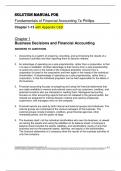Exam (elaborations)
Solution Manual For Fundamentals of Financial Accounting 7e Phillips Chapter 1-13 with Appendix C&D
- Course
- Institution
- Book
Chapter 1 Business Decisions and Financial Accounting ANSWERS TO QUESTIONS 1. Accounting is a system of analyzing, recording, and summarizing the results of a business‘s activities and then reporting them to decision makers. 2. An advantage of operating as a sole proprietorship, rather than ...
[Show more]



